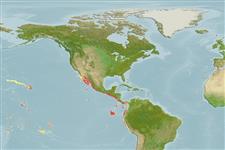>
Ophidiiformes (Cusk eels) >
Ophidiidae (Cusk-eels) > Ophidiinae
Etymology: Cherublemma: Greek, chry, diminutive of cheir = hand + Greek, blemma, -atos = the eyes (Ref. 45335).
More on author: Gilbert.
Environment: milieu / climate zone / depth range / distribution range
Ökologie
seewasser bathydemersal; tiefenbereich 102 - 740 m (Ref. 36413). Deep-water; 32°N - 16°S
Eastern Pacific: Baja California to northern Chile.
Length at first maturity / Size / Gewicht / Alter
Maturity: Lm 18.8 range ? - ? cm
Max length : 25.0 cm SL Männchen/unbestimmt; (Ref. 34024)
Kurzbeschreibung
Morphologie | Morphometrie
Rückenflossenstacheln (insgesamt): 0; Rückenflossenweichstrahlen (insgesamt): 99-113; Afterflossenstacheln 0; Afterflossenweichstrahlen: 81 - 98; Wirbelzahl: 55 - 58. Rostral spine well developed with vertical basal component which projects dorsally, and a long forward projecting straight component; peritoneum and guts black; narrow weak band of basibranchial teeth; bones thin, weakly developed (Ref. 34024). Branchiostegal rays: 7 (Ref. 36413).
Adults are found on soft bottoms, between 429 and 732 m in depth, while juveniles are encountered at shallower depths (Ref. 9329). Prejuveniles mesopelagic (Ref. 34024). Oviparous, with planktonic larvae and extended pelagic juvenile stage (Ref. 36413). Oval pelagic eggs float in a gelatinous mass (Ref. 205).
Nielsen, J.G., D.M. Cohen, D.F. Markle and C.R. Robins, 1999. Ophidiiform fishes of the world (Order Ophidiiformes). An annotated and illustrated catalogue of pearlfishes, cusk-eels, brotulas and other ophidiiform fishes known to date. FAO Fish. Synop. 125(18):178p. Rome: FAO. (Ref. 34024)
IUCN Rote Liste Status (Ref. 130435)
Bedrohung für Menschen
Harmless
Nutzung durch Menschen
Fischereien: nicht kommerziell
Mehr Information
ReferenzenAquakulturAquakultur ProfilZuchtlinienGenetikElectrophoresesVererbbarkeitKrankheitenVerarbeitungNutrientsMass conversion
Tools
Zusatzinformationen
Download XML
Internet Quellen
Estimates based on models
Preferred temperature (Ref.
123201): 9.4 - 13.8, mean 11.6 °C (based on 38 cells).
Phylogenetic diversity index (Ref.
82804): PD
50 = 1.0000 [Uniqueness, from 0.5 = low to 2.0 = high].
Bayesian length-weight: a=0.00257 (0.00122 - 0.00544), b=3.17 (2.99 - 3.35), in cm total length, based on LWR estimates for this (Sub)family-body shape (Ref.
93245).
Trophic level (Ref.
69278): 3.6 ±0.7 se; based on size and trophs of closest relatives
Widerstandsfähigkeit (Ref.
120179): mittel, Verdopplung der Population dauert 1,4 - 4,4 Jahre. (Assuming tmax>3).
Fishing Vulnerability (Ref.
59153): Low vulnerability (21 of 100).
